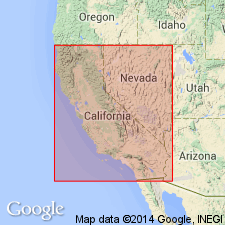
- Usage in publication:
-
- Ricardo formation
- Modifications:
-
- Named
- Biostratigraphic dating
- Dominant lithology:
-
- Tuff
- Fanglomerate
- Conglomerate
- AAPG geologic province:
-
- Mojave basin
Summary:
Name "Ricardo Pliocene", a series of beds occurring at Ricardo representing a faunal and stratigraphic stage which is distinctly pre-Pleistocene is "much later than Mohave Upper Miocene" was used by Merriam (1914, p.278). Ricardo formation occurs in western Mohave [Mojave] Desert area situated at eastern foot of Sierra Nevada Range. Consists in large part of tuffs with desert conglomerates or fanglomerates and other deposits formed on land and in evanescent water bodies. Is from 3000 to 5000 feet thick. Mammalian fauna from unit is of Hipparion-Merycodus zone, oldest of three Pliocene Stages in Great Basin province. Species are listed in report.
Source: GNU records (USGS DDS-6; Menlo GNULEX).
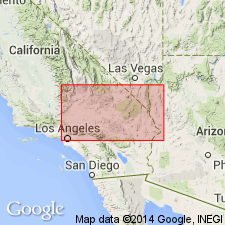
- Usage in publication:
-
- Ricardo formation*
- Modifications:
-
- Adopted
- AAPG geologic province:
-
- Mojave basin
Summary:
[Ricardo formation of Merriam (1914, 1917, 1919) is adopted.] Baker (1911) correlated Ricardo with "Rosamond series". Mammalian remains have been found in Ricardo and Barstow formations. Merriam therefore considers Ricardo to be early Pliocene and Barstow late Miocene age. No fossils were found in "Rosamond series"; it is doubtful whether "Rosamond" comprises deposits of stage represented at Ricardo. Age of Ricardo formation is early Pliocene.
Source: GNU records (USGS DDS-6; Menlo GNULEX).
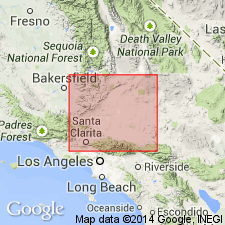
- Usage in publication:
-
- Ricardo Formation*
- Modifications:
-
- Biostratigraphic dating
- Overview
- AAPG geologic province:
-
- Mojave basin
Summary:
Ricardo Formation is sequence of terrestrial and volcanic rocks unconformably overlying Goler Formation and pre-Tertiary rocks and unconformably underlying Black Mountain Basalt in El Paso Mountains. Measured type section designated between Redrock and Last Chance Canyons is 5710 ft thick. Divided into informal units (ascending): (1) conglomerate, (2) basalt and tuff breccia, (3) conglomerate, (4) sandstone and tuff breccia, (5) amygdaloidal basalt and sandstone, (6) conglomerate and sandstone, (7) granitic sandstone (in Redrock Canyon), and (8) gravel and sand (fanglomerate). Age is early Pliocene (Clarendonian) on basis of mammalian fossils found in members 5,6, and 7.
Source: GNU records (USGS DDS-6; Menlo GNULEX).
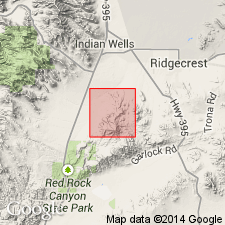
- Usage in publication:
-
- Ricardo Formation*
- Modifications:
-
- Age modified
- Geochronologic dating
- Overview
- AAPG geologic province:
-
- Mojave basin
Summary:
Eleven informal units and subunits of Ricardo Formation of Dibblee (1952) mapped in El Paso Mountains. Can be subdivided into three subdivisons (ascending); conglomerate unit of Bonanza Gulch, middle volcanic sequence, and upper conglomerate and sandstone unit. Detailed lithology and descriptions given for units. Age is Miocene based on radiometric ages 18.1 +/-1.2 Ma and 17.2 +/-0.8 Ma from lower part of formation and based on stratigraphic relations.
Source: GNU records (USGS DDS-6; Menlo GNULEX).
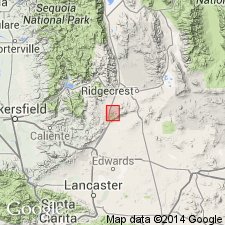
- Usage in publication:
-
- Ricardo Group
- Modifications:
-
- Revised
- Geochronologic dating
- AAPG geologic province:
-
- Mojave basin
Summary:
Ricardo Formation of Dibblee (1952, 1967) is raised to Ricardo Group and subdivided into (ascending); Cudahy Camp Formation and Dove Spring Formation (both new). Unconformably overlies Goler Formation; underlies fossiliferous lacustrine silt and clay of unknown Pleistocene age (Whistler, 1969). Age is Miocene based on radiometric ages of more than 18.1 Ma to less than 7 Ma (as shown in table).
Source: GNU records (USGS DDS-6; Menlo GNULEX).
For more information, please contact Nancy Stamm, Geologic Names Committee Secretary.
Asterisk (*) indicates published by U.S. Geological Survey authors.
"No current usage" (†) implies that a name has been abandoned or has fallen into disuse. Former usage and, if known, replacement name given in parentheses ( ).
Slash (/) indicates name conflicts with nomenclatural guidelines (CSN, 1933; ACSN, 1961, 1970; NACSN, 1983, 2005, 2021). May be explained within brackets ([ ]).

